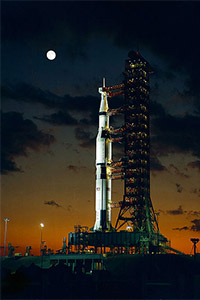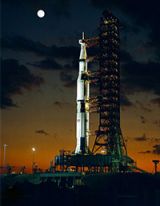Space exploration captured Americans’ imaginations in the 1960s and became a significant cultural touchstone in American history due to the Apollo programs and that iconic moment when man first walked on the moon in 1969. Lately, this sense of wonder seems to be fading as NASA gets less funding, private industry steps in to fill gaps left behind, and international actors rise to prominence. NASA has contributed numerous innovations to the American technology sector and significantly helped the American economy over the last few decades. More needs to be done today to promote public engagement in the space program and more collaborative measures need to be undertaken by governments domestically and internationally if the United States wishes to remain at the forefront of space exploration and technology.

| Early morning view on November 9, 1967 of Pad A, Launch Complex 39, Kennedy Space Center, showing Apollo 4 Saturn V prior to launch later that day. This was the first launch of the Saturn V. (Photo: NASA) |
On April 17, 2014, the Strategic Foresight Initiative convened experts on space exploration and advocacy to discuss the future of space exploration and the measures that need to be taken to ensure its success. One main point that was touched upon was the importance of public perception. Today, everyone is fighting for public attention and the space community needs to work harder to brand itself so that others are made aware of and engaged in the sector’s advances. It is also crucial to gain more bipartisan support from congressmen and women so that effective legislation is passed in favor of a more aggressive exploration program.
Discussants also touched upon the need for a plan, backed by strong leadership, advocacy, and more interactive education to involve younger generations. Today’s youth don’t have the same attachment to the wonders of space as Americans from decades ago, and it is time that government agencies and companies collaborate to educate and build a community of children and young adults who will directly contribute to the future of space exploration. NASA has been actively working to reform STEM education to drum up interest in middle school and high school students.
All in all, space exploration poses immense economic and scientific possibilities for our future but it is going to take a plan, commitment, and investment to take full advantage of this potential.
